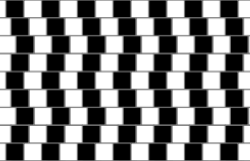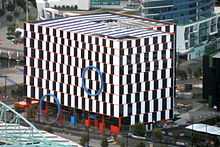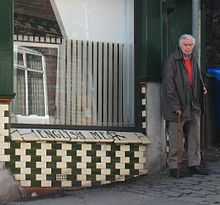Café wall illusion

The café wall illusion is a geometrical-optical illusion in which the parallel straight dividing lines between staggered rows with alternating black and white "bricks" appear to be sloped.
It was first described under the name Kindergarten illusion[1] in 1898, and re-discovered by Richard Gregory[2] in 1973. According to Gregory, this effect was observed by a member of his laboratory, Steve Simpson, in the tiles of the wall of a café at the bottom of St Michael's Hill, Bristol. It is a variant of the shifted-chessboard illusion originated by Münsterberg.[3]
In the construction of the optical illusion often each "brick" is surrounded by a layer of "mortar"[4] intermediate between the dark and light colours of the "bricks".
In the first and quite successful attempt at its deconstruction[5] the illusion was ascribed largely to irradiation, the light spread from dark to bright zones in the retinal image, and indeed the image disappears when black and white are replaced by different colours of the same brightness (isoluminant).[6] But a component of the illusion remains even when all optical and retinal components are factored out. Contrast polarities seem to be the determining factor in the tilt's direction.[7]


See also
- Visual illusions
- Geometrical-optical illusions
References
- ↑ Pierce, A.H. (1898). The illusions of the kindergarten patterns. Psych. Review, 5 (3), 233-253.
- ↑ Gregory RL, Heard P (1979). "Border locking and the Cafe Wall illusion" (PDF). Perception 8 (4): 365–80. doi:10.1068/p080365. PMID 503767.
- ↑ Münsterberg, H. (1897). Die verschobene Schachbrettfigur. Zeitschrift für Psychologie, 15, 184-188
- ↑ Morgan, M.J., & Moulden, B. (1986). The Münsterberg figure and twisted cords. Vision Research 26, 1793-1800
- ↑ Pierce, A.H. (1901). Studies in Auditory and Visual Space Perception. (London: Longmans Green.
- ↑ Westheimer, G. (2007). Irradiation, border location and the shifted-chessboard pattern. Perception, 36, 483-494
- ↑ Kitaoka A, Pinna B, Brelstaff G, (2004). "Contrast polarities determine the direction of Cafe Wall tilts" (PDF). Perception 33 (1): 11–20. doi:10.1068/p3346. PMID 15035325.
External links
- An interactive web app for demonstrating the Café wall illusion
- An interactive version of the Café wall illusion that allows for adjusting the offset and turning the black boxes into white boxes
- An animated proof that the horizontal lines are parallel and straight
- The original café in Bristol on Google Maps Street View
| ||||||||||||||||||||||||||||||||